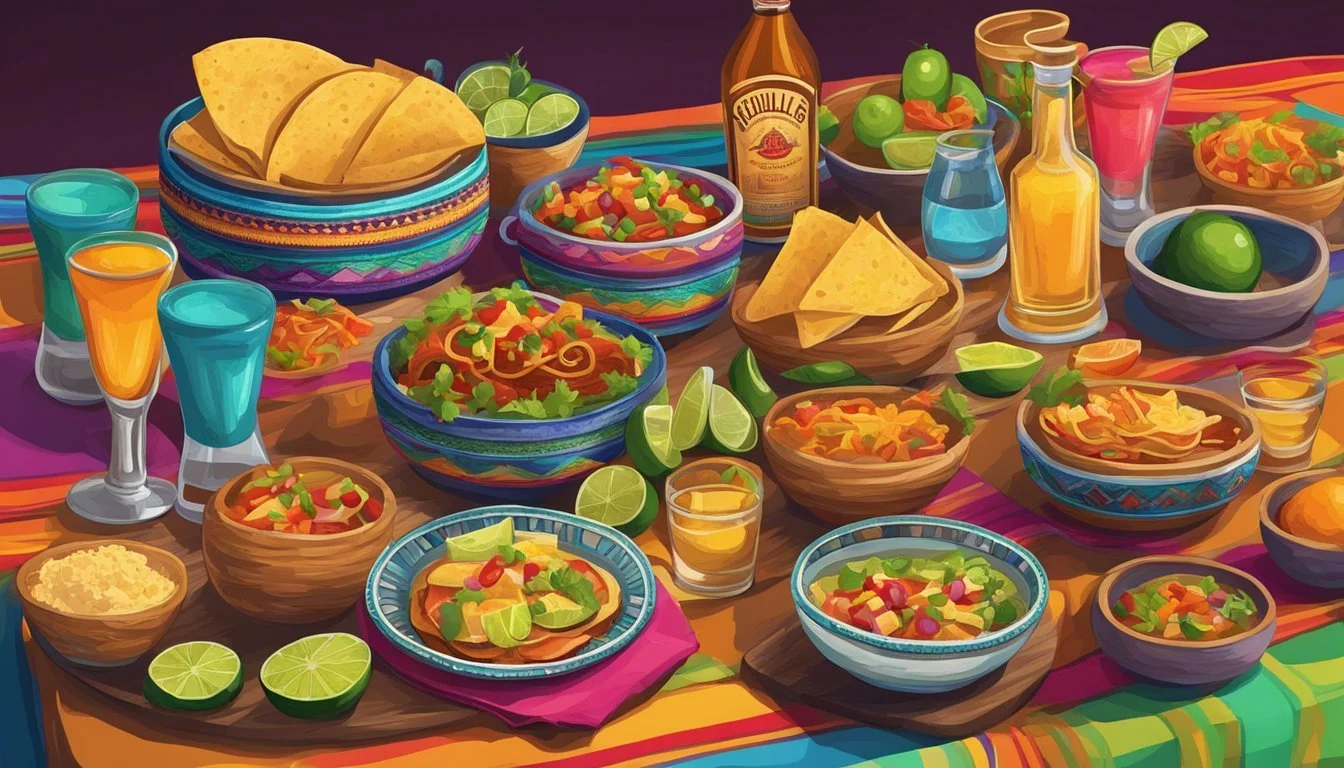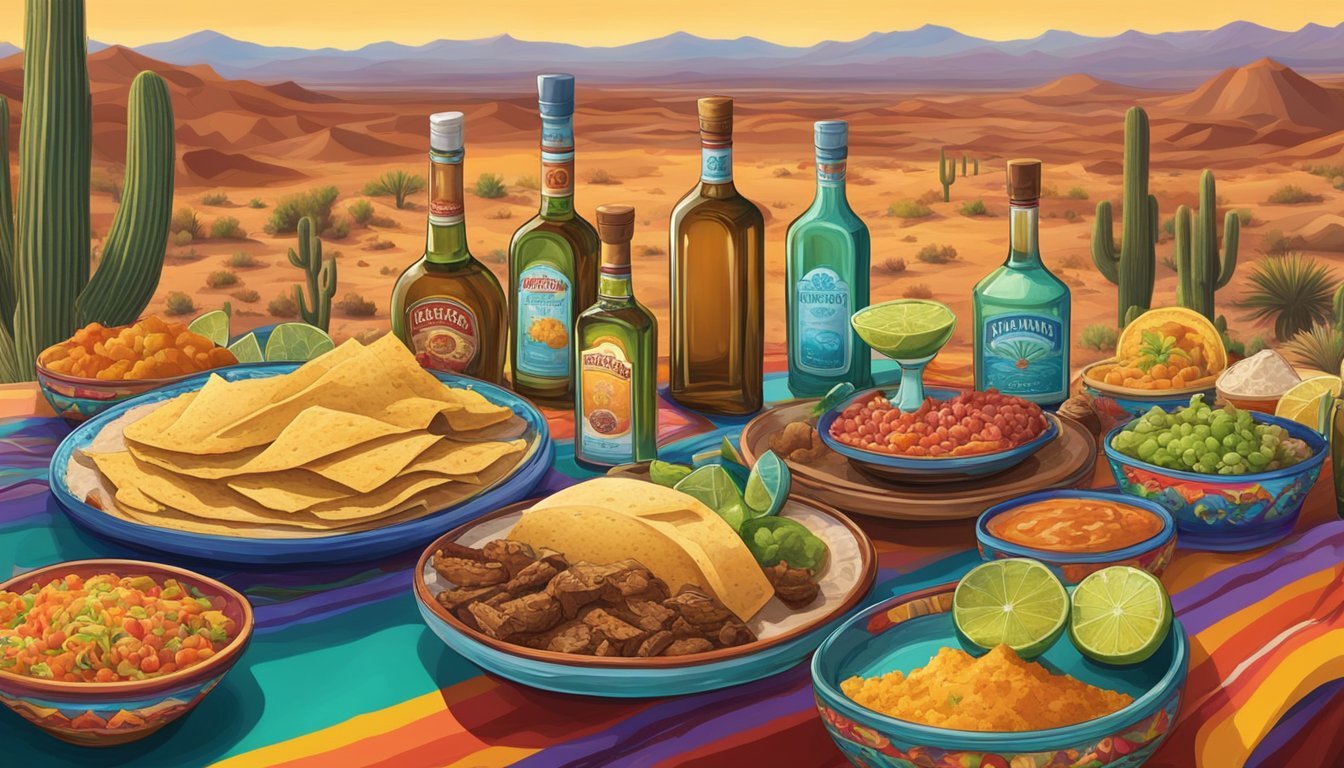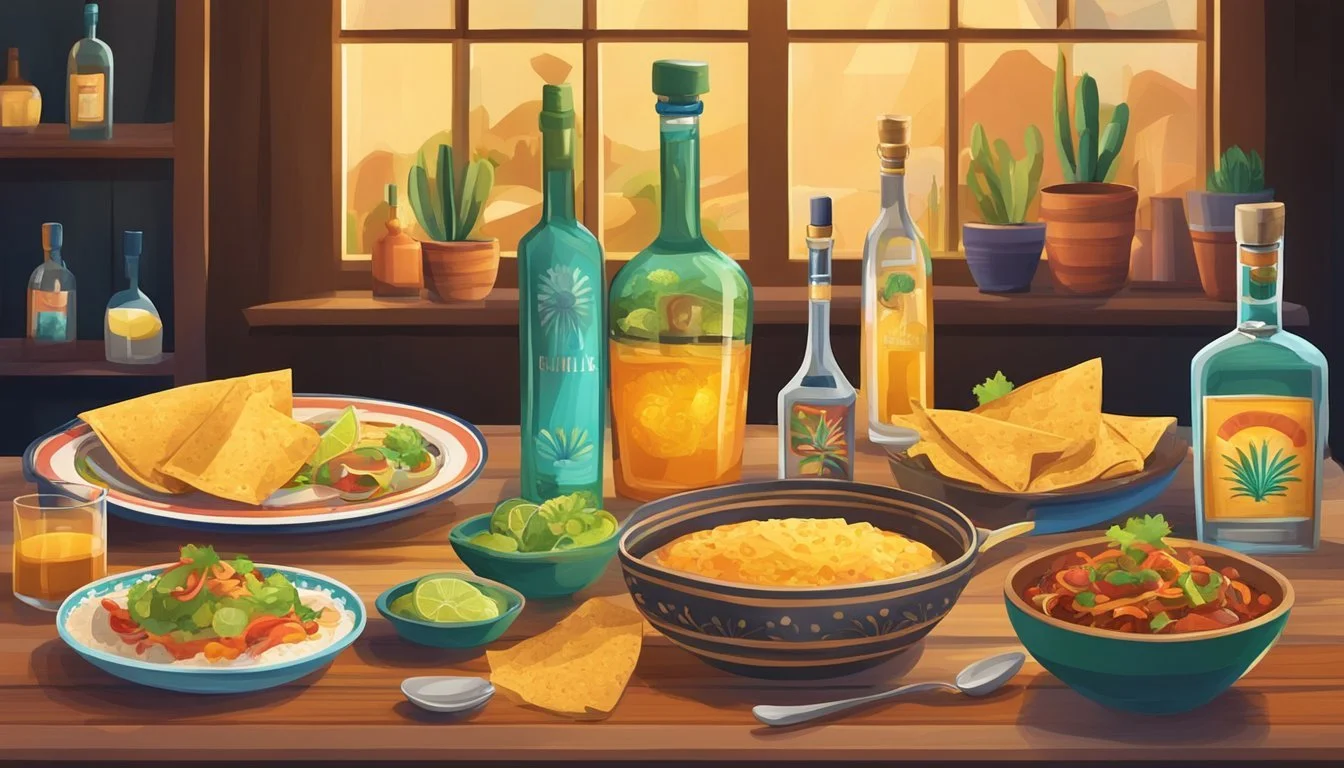The Art of Tequila and Food Pairings
Exploring Culinary Synergy in Texas Cuisine
Tequila, a spirit distilled from the blue agave plant, has long been a staple of Mexican culture and has been embraced with gusto in the culinary traditions of Texas. While often relegated to shots and cocktails, tequila's complex range of flavors makes it an excellent partner for a variety of dishes. With notes ranging from sweet and floral to earthy and spicy, depending on the aging process and agave species, this versatile spirit harmonizes beautifully with the bold flavors of Texan and Mexican cuisines.
In Texas, the art of pairing tequila with food is an experience that transcends mere consumption, reflecting a deep appreciation for the nuanced flavors born from the blue agave plant. The state's penchant for barbecues, Tex-Mex dishes, and hearty stews offers a unique canvas for showcasing the harmony between tequila and regional fare. It's not merely about finding a fitting match for the palate; it's about elevating the entire dining experience through thoughtful combinations that highlight the distinct notes of agave.
Understanding the types of tequila is crucial to mastering such pairings. Blanco, or silver tequila, with its pure and unaged profile, pairs splendidly with fresh, zesty dishes such as ceviche or grilled seafood. Reposado, aged slightly longer, takes on a mellow character that complements richer foods like roasted pork. Añejo, with its nuanced caramel and vanilla notes from extended aging, finds its match in the sweet and complex layers of desserts or the bold spice of smoked meats. Each type offers a special conversation with food, guiding the palate through a symphony of taste where both elements – food and tequila – shine.
The Essence of Tequila
In the exploration of tequila's essence, it is essential to understand its deep historical roots, the variety of types available, the foundational role of the agave plant, and the intricate process of aging that contributes to its unique flavors.
Tequila's Historical Roots in Jalisco
Tequila originates from the Jalisco region of Mexico, a land with over 250 years of history in tequila production. The state's volcanic soil and climate are ideal for growing the blue agave plant, which is the cornerstone of tequila. Jalisco's contribution to the tequila industry is so significant that the spirit can only be called tequila if it is produced in this region and a few other specific areas in Mexico.
Understanding the Types of Tequila
Tequila is categorized into several types based on aging:
Blanco tequila, also known as silver or white tequila, is bottled immediately after distillation or aged for less than two months.
Reposado tequila is aged in wood barrels for two months to one year, taking on a golden hue and a smoother character.
Añejo tequila undergoes an aging process of one to three years, often in oak barrels, becoming richer and more complex.
Extra Añejo tequila is a relatively new category, representing tequilas aged for more than three years, offering the deepest flavors and most luxurious experience.
The choice of wood and the time spent aging significantly impact the tequila's final flavor profile.
The Agave Plant: Blue Agave and Beyond
The blue agave plant, or Agave tequilana, is the only species used to make authentic tequila. Its core, known as the piña, is harvested and cooked to create the tequila's base. While blue agave is the standard, the industry experiments with other agave varieties for crafting different agave spirits, like mezcal.
The Process of Aging Tequila
Aging tequila is an art that transforms the clear liquid into a robust and color-infused spirit with a variety of nuanced flavors. Aging takes place in wooden barrels, usually oak, which impart characteristics such as vanilla, caramel, and spice.
Blanco Tequila: Usually unaged, it offers a pure taste of the agave plant.
Reposado Tequila: Aged in oak, it develops a smoother taste with wood notes.
Añejo Tequila: Aging in oak yields complexity with a balance of agave and wood flavors.
Extra Añejo Tequila: The extended time in the barrel produces a tequila with an intricate taste and complexity.
By understanding these elements, one can truly appreciate the essence and craftsmanship behind every bottle of tequila.
Fundamentals of Food and Tequila Pairings
Pairing food with tequila involves a complex interplay of flavors where both the beverage and the food enhance each other. It’s crucial to understand the profiles of different tequilas and how they can complement or contrast with food.
Balancing Flavors and Contrasts
When pairing tequila with food, it's essential to balance flavors. The goal is to either provide a contrasting experience that highlights the unique properties of both the tequila and the dish or to create a harmonious blend where flavors complement each other. For instance, Añejo tequilas, with their notes of vanilla, caramel, and sometimes chocolate (What wine goes well with chocolate?), pair well with rich desserts or aged cheeses that echo these tasting notes.
Effect of Citrus and Acidity
Citrus plays a pivotal role in tequila pairings, often cutting through the richness of food. The sharpness of lime or lemon can highlight a tequila's crisp, refreshing qualities, especially in lighter blancos. Acidity helps to reset the palate between sips, making acidic components like ceviche or dishes with a squeeze of lime natural partners for tequila.
Role of Spiciness and Earthy Notes
The inherent spiciness of tequila, particularly those with earthy underpinnings, calls for foods that can stand up to its bold flavors. Spicy and nutty snacks resonate well with tequila's profile. Additionally, smoky flavors found in some tequilas, achieved the roasting process of the agave plant, can be incredibly complementary to barbecued meats (What wine goes well with barbecued meats?) or grilled vegetables. (What wine goes well with grilled vegetables?)
Tequila Pairing Guidelines
To simplify the pairing process, here are concise guidelines to consider:
Blanco/Silver Tequila: These unaged spirits are clean and crisp with a smooth finish, making them ideal for pairing with seafood, light proteins, and salads.
Reposado Tequila: Aged in oak barrels for two months to a year, reposados develop a soft golden hue with hints of wood and sweet agave. They work well with grilled chicken, pork, and vegetables.
Añejo Tequila: With one to three years in barrels, añejos exhibit complexity and deeper flavors of caramel and spices—perfect for red meats and rich desserts.
Food and spirit pairings focus on enhancing the tasting experience, taking both the drink and the dish to a new level of enjoyment.
Showcasing Mexican Cuisine
In Texas, the fusion of local flavors with Mexican culinary traditions creates a distinctive tableau of taste perfect for pairing with Tequila.
Tequila and Traditional Mexican Dishes
Tacos: An essential dish in Mexican cuisine, tacos offer unlimited possibilities for Tequila pairings. A blanco Tequila, known for its pure agave flavor, shines alongside fish tacos, accentuating the fresh taste of the sea. When it comes to beef or pork tacos, one might consider a reposado Tequila, which introduces subtle notes of vanilla and oak to the smoky, spicy flavors of the meat.
Ceviche: This citrus-marinated seafood dish requires a Tequila that complements its bright acidity. The herbaceous notes of a highland Tequila can enhance the freshness of ceviche, creating a harmonious blend with the lime juice and cilantro.
Guacamole & Salsa: These staples, featuring ripe avocados, tomatoes, onions, and jalapeño, are an invitation to explore the pairing potential of Tequila. A light reposado can match the creaminess of guacamole, while a peppery blanco may elevate the heat in a fiery salsa.
Panela and Mexican Cheese: The mild, fresh flavors of Mexican cheeses like Panela call for a Tequila that won't overshadow their subtlety. A well-chosen joven Tequila can offer a balance without dominating the palate.
Modern Twists on Tequila Pairings
The contemporary Texas culinary scene has embraced innovative twists on traditional pairings, meshing local ingredients with Mexican influences.
Seafood: Spiced shrimp or grilled octopus find a match in aged Tequilas, such as añejos, which have the complexity to stand up to bold flavors and charred notes.
Corn-based delights: Corn, a cornerstone of Mexican cuisine, is often featured in dishes like quesadillas. Pair these with a reposado Tequila to bring out the earthy sweetness of the corn, perfectly complementing the melted cheese and spicy elements.
Jalisco-inspired flavors: As the birthplace of Tequila, Jalisco's culinary exports like birria (a spicy stew) pair naturally with Tequilas from the region, particularly ambers with their warming, spicy undertones.
List of ideal pairings for a Texas-inspired Mexican culinary experience:
Tacos with Blanco Tequila
Ceviche with Highland Tequila
Guacamole with Reposado Tequila
Salsa with Peppery Blanco Tequila
Quesadillas with Reposado Tequila
Birria with Amber Tequila
By considering the nuances of each dish, Texas chefs and connoisseurs confidently highlight the incredible versatility of Tequila as not just a drink, but a key component of Mexican cuisine.
Expanding the Culinary Horizons
In a quest for culinary innovation, tequila pairings are not confined to Tex-Mex favorites; instead, they cross cuisines and borders. The exploration of global food pairings with tequila brings a new level of appreciation for this versatile spirit.
Tequila Beyond Borders: Global Food Pairings
Steak: A robust cut like a ribeye pairs well with añejo tequila, which has a bold, smoky flavor profile that complements the rich, meaty taste of the steak.
Pork: Reposado tequila, with its balanced oak and agave notes, enhances the savory flavors in dishes like slow-cooked pork carnitas (What wine goes well with pork carnitas?) or grilled pork chops. (What wine goes well with pork chops?)
Table: Recommended Tequila for Various Meats
Meat Type Tequila Type Reasoning
Steak Añejo Smoky notes of aged tequila match rich steak
Pork Reposado Oaky tones highlight savory pork
Sushi/Sashimi Blanco Clean, crisp taste pairs with delicate fish
Vegetables and Cheeses:
Grilled vegetables, especially bell peppers and zucchini, find a harmonious match in the herbal qualities of silver tequila. As for cheeses, gouda and manchego pair particularly well; their nutty-and-sweet characteristics are heightened by the smooth finish of a high-quality reposado.
Seafood:
Dishes like sushi (What wine goes well with sushi?) and sashimi, often complemented with a clean, crisp blanco tequila, bring out the nuanced flavors of both the fish and the spirit.
Smoked salmon or seared tuna can align with the fruity notes present in some highland tequilas.
Desserts:
Desserts create exciting pairing opportunities, where the inherent sweetness and complexity of tequila can be paired effectively. A properly matched añejo can accent dark chocolate's rich flavors, making for a decadent sensory experience.
Nuts:
When it comes to snacks, a simple variety of nuts—almonds, cashews, or peanuts—can be uplifted when served alongside a glass of reposado, which complements their salty and earthy nature.
List: Ideal Tequila Pairings for Desserts and Snacks
Dark Chocolate: Añejo tequila
Cheese: Reposado tequila (especially with gouda and manchego)
Nuts: Reposado tequila
Each pairing is intended to respect the unique characteristics of the food, while the tequila serves to enhance, not overshadow, the flavor profile of these global dishes.
Tequila in Modern Gastronomy
In Texas, tequila is not just a beverage; it's an integral part of culinary innovation, elevating dishes and cocktails with its unique flavors derived from meticulous aging processes and natural ingredients.
Innovative Tequila Infusions and Cocktails
Infusions: Tequila's adaptability makes it a perfect canvas for infusions. Bartenders are experimenting with a range of flavors, from the sweet and creamy notes of vanilla and banana to the more robust tones of cinnamon and cacao percentages. These infusions enhance the natural flavors of the agave spirit and serve as a foundation for complex cocktails.
Cocktails: The classic margarita, with its refreshing blend of tequila, lime, and sweetness, remains a staple in Texan mixology. However, modern gastronomy sees it evolving into more intricate variants. Aging tequila in wood barrels contributes vanilla and toffee notes, which mixologists skillfully incorporate into contemporary cocktails, offering a nuanced experience for the palate.
2 parts Tequila (aged for complexity)
1 part Fresh Lime Juice
1/2 part Agave Nectar or Simple Syrup
Lime wheel for garnish
Salt rim optional
By focusing on the quality of aging and the harmony of botanicals and spices, Texas gastronomy proudly showcases the versatility of tequila in the evolving landscape of modern cuisine.
Pairing Tequila with Occasions
In Texas, tequila is not just a drink, it's a celebratory staple that varies widely to suit different events. From the laid-back barbecue to the polished dinner event, specific tequila pairings can profoundly enhance the culinary experience.
Casual Gatherings and Tequila Pairings
Casual Texan socials often revolve around hearty foods and shared moments. For burgers and grilled meats, a reposado tequila with its oaky richness complements the savory flavors. The hint of sweetness and subtle smoky nuances join forces with the charred crust of the meats. When it comes to chips and salsa, a silver or blanco tequila is a go-to choice. Its crisp, clean taste cuts through the spice and refreshes the palate.
Mexican Food: (What wine goes well with Mexican food?) Blanco tequila with notes of citrus; perfect for cutting through rich avocado or guacamole-based dishes.
Bacon-Wrapped Delights: Reposado’s smoky undertones pair excellently with bacon's salty crispness.
Sophisticated Events and Select Pairings
A more upscale event demands tequilas with complexity and a certain finesse. Añejo tequilas, aged longer, offer a deeper flavor profile that can stand up to red meat selections. These tequilas often exhibit hints of vanilla and dried fruit, which harmonize beautifully with orange-glazed duck or pork. For appetizers, consider pairing a delicate blanco tequila with fresh avocado or seafood ceviche.
Elegant Mexican Cuisine: Añejo or extra añejo, which offers a smooth finish, can elevate a dish like mole poblano.
Bacon-centered Dishes: A high-end añejo can mirror the smokiness and richness of bacon, enhancing its taste.
Toasting to Texas traditions or celebrating in style, the right tequila pairing makes all the difference.
Tequila Pairing Tips and Tricks
When pairing tequila with food, one must consider the complexities of flavor profiles in both the tequila and the dish for a harmonious experience. The nuances of a high-end tequila's natural sweetness and earthy undertones can either complement or contrast with various ingredients and cooking methods to enhance the dining experience.
Pairing Tequila with Different Cooking Methods
Grilled Dishes (What wine goes well with grilled dishes?): Tequila's smoky undertones pair beautifully with grilled foods. A reposado, with its balance of agave and woody notes, complements the charred flavors inherent in grilled meats and vegetables.
Raw Fish: A blanco tequila, known for its clean and crisp flavors, pairs well with the delicate taste of raw fish, such as in ceviche. The tequila's subtle sweetness and hints of citrus can elevate the fresh and zesty notes brought on by lemon or lime marinades.
Choosing Tequila Based on Dish Ingredients
Acidic Components: When a dish features acidic components like citrus or vinegar, one should opt for a tequila that can stand up to the tartness without being overpowered. A joven tequila, which often has a more aggressive edge, can complement dishes with pronounced acidity.
Cheese: Añejo tequila, with its richer, more complex flavor due to extended aging, pairs exceptionally well with the creamy and potent flavors of aged cheeses.
Cheese Type Tequila Pairing
Aged Cheddar Añejo Tequila
Manchego Reposado Tequila
Spicy Elements: Beverages with a hint of sweetness can counterbalance the heat in spicy foods. A tequila with mellow sweetness can soften the sharpness of jalapeño or other hot peppers, making a well-balanced pairing.
Vegetables: When it comes to fresh vegetables, a light reposado can complement the earthiness of ingredients such as olives, enhancing the overall flavor profile with its smooth finish.
Conclusion: The Art and Science of Tequila Pairings
Tequila, a spirit of complexity, offers a symphony of flavors that can both complement and enhance a myriad of dishes. Understanding the science behind tequila pairings is about recognizing the harmony between the food's flavor profiles and the distinct characteristics of blanco, reposado, and añejo tequilas.
Blanco, known for its crisp and earthy notes, pairs well with the freshness of ceviche or the zest in a tangy salsa.
Reposado, with its subtle oak and caramel undertones, complements the savory richness of carnitas or grilled bone marrow.
Añejo, offering deeper notes of vanilla and dried fruit, can be the perfect accompaniment to the boldness of chocolate desserts (What wine goes well with chocolate desserts?) or the warmth of a mole sauce.
The pairing of Mexican food and tequila is an art that reflects a deep understanding of how the spices and herbs interact with the spirit's unique qualities. Traditional dishes create a canvas for tequila's versatility, where every sip can enhance the culinary experience.
In the world of cocktail creation, the mixologist becomes the artist, carefully selecting tequila as a base to craft beverages that not only resonate with the food but elevate the taste. Whether through a classic Margarita or a more imaginative concoction, this pairing invites one to explore beyond the expected.
The artful blend of tequila and food hinges on balance and contrast, engaging one's palate and inviting a deeper appreciation for both the spirit and the cuisine. Tequila pairings are not rigid rules but a guide for culinary adventure—each individual's taste buds serve as the final judge.








